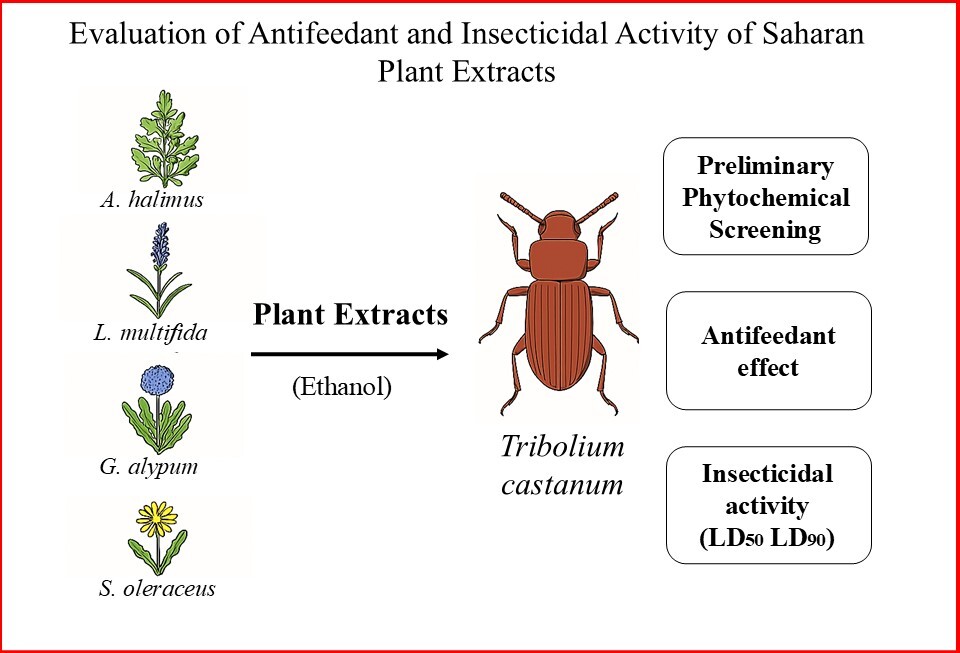ORIGINAL ARTICLE
Antifeedant and insecticidal activity of four medicinal plants from arid regions on adults of the red flour beetle Tribolium castaneum (Coleoptera, Tenebrionidae)
1
Department of Agricultural Sciences, University of Biskra, BP 145 RP, 07000 Biskra, Algeria, 07000, Biskra, Algeria
2
Laboratory of Ecosystems Diversity and Agricultural Production Systems Dynamics in Arid Zones (DEDSPAZA), University of Biskra, BP 145 RP, 07000 Biskra, Algeria, 07000, Biskra, Algeria
3
Laboratory of Development of Automatic and Intelligent Control Systems in Agriculture in Arid Regions, University of Biskra, BP 145 RP, 07000 Biskra, Algeria, 07000, Biskra, Algeria
4
Departement of Industrial Chemistry, University of Biskra, BP 145 RP, 07000 Biskra, Algeria, 07000, Biskra, Algeria
A - Research concept and design; B - Collection and/or assembly of data; C - Data analysis and interpretation; D - Writing the article; E - Critical revision of the article; F - Final approval of article
Submission date: 2025-01-29
Acceptance date: 2025-09-30
Online publication date: 2025-11-04
Corresponding author
Mouna ATTAFI
Department of Agricultural Sciences, University of Biskra, BP 145 RP, 07000 Biskra, Algeria, 07000, Biskra, Algeria
Department of Agricultural Sciences, University of Biskra, BP 145 RP, 07000 Biskra, Algeria, 07000, Biskra, Algeria
HIGHLIGHTS
- First evaluation of four Medicinal Saharan plants against Tribolium castaneum adults
- Insecticidal and antifeedant activities tested under lab conditions
- Preliminary phytochemical screening revealed phenolic compounds in the tested plants
- Findings support the potential use of Saharan plants for sustainable pest management
- Further studies are needed to confirm and optimize their effectiveness
KEYWORDS
TOPICS
ABSTRACT
Considering the importance of sustainable pest control, this study evaluated the insecticidal and antifeedant properties of medicinal plants from arid regions against Tribolium castaneum. The methodology involved extracting bioactive compounds from four selected plant species: Atriplex halimus L. (saltbush), Sonchus oleraceus L. (sowthistle), Lavandula multifida L. (fernleaf lavender) and Globularia alypum L. (globe daisy), and conducting antifeedant and insecticidal bioassays, along with phytochemical screening tests, to assess their effects on adult beetles. The primary findings indicated that Lavandula multifida and Sonchus oleraceus manifested notable insecticidal activity, underscoring their promise as efficacious natural pest management agents, despite their modest antifeedant activities. Notably, Atriplex halimus demonstrated remarkable antifeedant activity, achieving a 31.37% effect, though its insecticidal activity was somewhat modest. Globularia alypum showed minimal insecticidal and antifeedant activity. However, the utilization of Lavandula multifida as a bioinsecticide may be limited by the plant's small size, which necessitates the production of a considerable quantity of plant material to produce a sufficient extract. Phytochemical analysis indicated that these plants are rich in bioactive compounds, including flavonoids, terpenoids, and tannins. The observed differences between insecticidal and antifeedant activities suggest the presence of different underlying mechanisms. This study underscored the potential of these plant extracts as environmentally friendly alternatives to synthetic pesticides and lays the groundwork for future research into their role in sustainable pest management strategies.
CONFLICT OF INTEREST
The authors have declared that no conflict of interests exist.
Share
RELATED ARTICLE
We process personal data collected when visiting the website. The function of obtaining information about users and their behavior is carried out by voluntarily entered information in forms and saving cookies in end devices. Data, including cookies, are used to provide services, improve the user experience and to analyze the traffic in accordance with the Privacy policy. Data are also collected and processed by Google Analytics tool (more).
You can change cookies settings in your browser. Restricted use of cookies in the browser configuration may affect some functionalities of the website.
You can change cookies settings in your browser. Restricted use of cookies in the browser configuration may affect some functionalities of the website.




